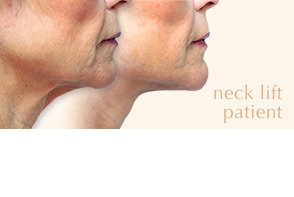Breast Reduction Surgery
About breast reduction in Asheville, NC
Being happy with your breast size is important. For many women, that means getting smaller, lighter breasts. If you feel your breasts are too large for your frame or interfere with your ability to live comfortably, breast reduction surgery can help free you from the physical and emotional discomfort of having very large, heavy breasts.
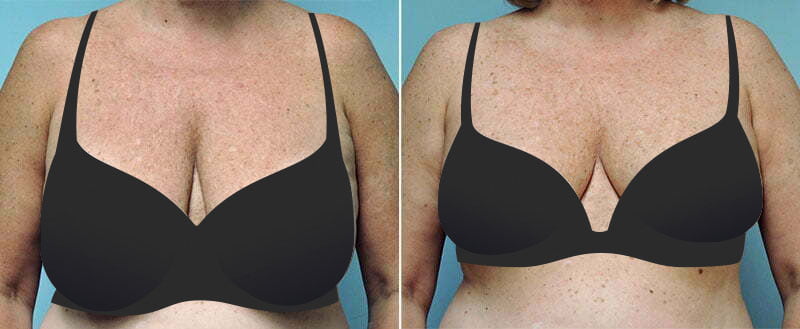
Why have breast reduction surgery?
Each of our patient’s reasons for choosing breast reduction surgery are unique to the individual. While breast reduction is commonly chosen to help alleviate back, neck and shoulder discomfort, the procedure can have a very positive impact on emotional well-being, helping a patient feel more confident in her appearance and eliminating unwanted attention from others.
Enjoy an approved appearance and an increase in comfort
Patients enjoy a number of aesthetic as well as physical benefits following their reduction:
- Your breasts will have an improved, more youthful shape and symmetry
- Bras will fit more comfortably and provide better support
- Chronic chafing, shoulder grooves and skin irritation caused by heavy, pendulous breasts are eliminated
- Running, dancing and other sports become more enjoyable
- Comfortable, figure-flattering clothing is often easier to find
Am I a good candidate?
Breast reduction patients are very diverse. Asheville plastic surgeon Dr. Donald Conway has worked with patients of all ages and backgrounds. While insurance companies require a certain amount of breast tissue be removed before they will cover the procedure, there is no “magic number” regarding breast size that you must have to benefit from breast reduction. Far more important than your age or current breast size is a desire to improve your breast contour so that you can improve your quality of life. If the following describes you, a breast reduction may be worth considering:
- You feel your breasts are disproportionately large for your body
- You are at a healthy, stable body weight and do not smoke
- You would like a smaller aesthetic breast shape
- You avoid certain activities due to having larger, heavy breasts
- You have a hard time finding bras that fit and support properly
Why choose Dr. Conway as your breast surgeon

Dr. Donald Conway
Donald Conway, MD specializes in cosmetic and reconstructive breast surgery in Asheville, North Carolina. While a major goal of breast reduction surgery is to reduce breast size and weight, board certified plastic surgeon Dr. Conway’s ultimate goal is to help women feel beautiful and comfortable in their own bodies. He applies his surgical expertise and artistic skill to create a new, more aesthetically pleasing breast shape that looks natural with a patient’s unique body contours while improving breast symmetry. He listens to each patient’s individual goals, developing a surgical plan to achieve her desired breast contour as closely as possible.
About the procedure
Dr. Conway performs breast reduction as an outpatient procedure at our fully accredited, on-site surgery suite at our Plastic Surgery Center in Asheville, NC. General anesthesia is provided by a board certified MD anesthesiologist. Using the incision patterns discussed at your consultation, Dr. Conway will remove excess breast tissue, fat and skin, adjusting the amount taken from each breast to achieve optimal symmetry. He will then lift and reshape the remaining breast tissue, relocating the nipple and areola to a more forward-facing position in the middle of the breast.
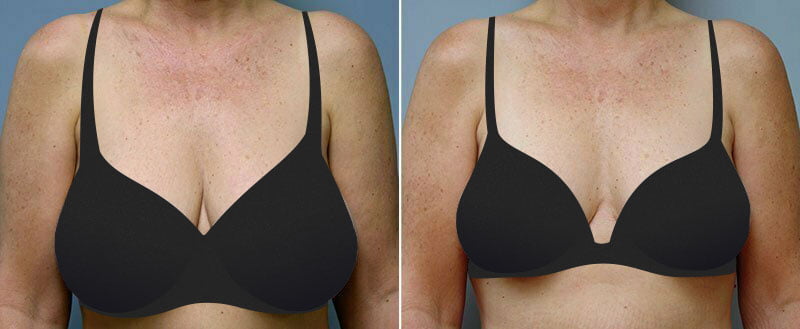
- Key Benefits
- Glossary
- Relief from Physical Discomfort: Breast reduction surgery can alleviate back, neck, and shoulder pain often caused by the weight of overly large breasts.
- Improved Posture: Reducing breast size can help correct posture issues that arise from the strain of heavy breasts.
- Enhanced Mobility and Physical Activity: Smaller, lighter breasts can make it easier and more comfortable to engage in physical activities and exercise.
- Reduced Skin Irritation: The surgery can alleviate skin irritation and rashes that frequently occur under large breasts.
- Corrects Breast Asymmetry: The procedure can correct asymmetrical breasts, making them more even in size and shape.
- Long-Lasting Results: Breast reduction provides permanent results, significantly reducing breast size for the long term.
- Anesthesia: Medication used during surgery to prevent pain; can be either local anesthesia (numbing a specific area) or general anesthesia (inducing sleep).
- Areola: The pigmented skin surrounding the nipple; can be resized or repositioned during breast reduction surgery.
- Breast Reduction (Reduction Mammaplasty): A surgical procedure to remove excess breast fat, glandular tissue, and skin, making breasts smaller, lighter, and more proportionate to the body.
- Gigantomastia: A rare medical condition characterized by excessive breast growth that can cause physical discomfort and emotional distress, often treated with breast reduction surgery.
- Incision: A surgical cut made in the skin; in breast reduction, common patterns include around the areola, vertically down from the areola to the breast crease, and along the breast crease.
- Liposuction: A surgical technique used to remove fat; sometimes used in breast reduction to remove excess fatty tissue from the breasts.
- Mammogram: A breast X-ray used for screening and diagnosis of breast diseases; important for patients undergoing breast reduction to monitor breast health.
- Nipple-Areola Complex: The combined structure of the nipple and the surrounding areola, which may be moved higher on the breast during a reduction procedure.
- Postoperative Care: The care and instructions provided after surgery, critical for ensuring a successful recovery from breast reduction.
- Recovery Time: The period post-surgery during which patients heal, commonly involving rest and limited physical activity.
- Vertical Scar Technique: A breast reduction technique that leaves a scar around the areola and a vertical scar beneath it, often resulting in less scarring than traditional methods.
- Wise Pattern Reduction: A common technique for breast reduction that results in an anchor-shaped scar, involving an incision around the areola, vertically down, and along the breast crease.
Breast reduction incisions & scars
Dr. Conway typically performs breast reduction surgery using either a vertical or “lollipop”, or an inverted-T or “anchor” technique. Both involve one incision around the outer edge of the areola and one incision running vertically from the bottom of the areola to the crease beneath the breast. The inverted-T technique involves one additional incision running within the crease beneath the breast (the inframammary fold).
Resulting scars from incisions made via either method are easily hidden beneath a bra or swimsuit. With proper care, incisions should fade significantly over the course of a year or two, after which many women find they barely notice their scars.
Recovery
Recovery following breast reduction is typically a very smooth, shorter-than-expected process for most patients. You will be up and walking around at home the evening after surgery, although you will need some help getting around. After mostly resting the first 1-2 days as anesthesia effects wear off, most patients feel ready to resume light activities, such as easy-paced walking or working at a desk, after 3-7 days, depending on the extent of their procedure.
Pain is typically well-tolerated with pain medications for the first couple of days of recovery, and most patients are fine with Tylenol thereafter. Driving is permitted when you are no longer on prescription pain medicine, you are comfortable twisting your neck and shoulders, and you have been cleared to do so by Dr. Conway. Aerobic exercise and other non-contact sports can typically be resumed after 3 or 4 weeks, and most patients are back to their usual routines about 6 weeks following breast reduction surgery.
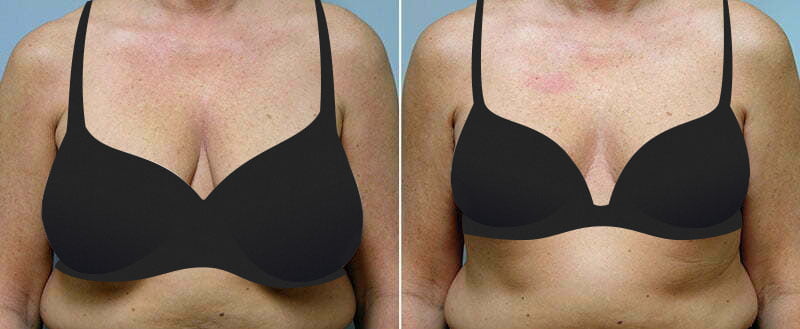
What will my breast size be after reduction surgery?
This is a common question among women, most of whom are eager to shop for smaller, better-fitting bras after surgery. Breast reduction is in no way a “one-size-fits-all procedure.” Your final breast size will depend on the size of your breasts before surgery, your proportions, and your desired size decrease, as well as the amount of tissue that needs to be removed to decrease any physical symptoms you have experienced as a result of your breast size.
Initially, your breasts will appear swollen and may seem asymmetrical after breast reduction surgery. This is a normal after-effect from surgery, and your breast shape and size will improve over the weeks following your procedure. While your new breasts will continue to make subtle improvements for up to a year after surgery, most women are very satisfied with their appearance by 8 weeks, and results are very close to their final appearance within 3 to 4 months.
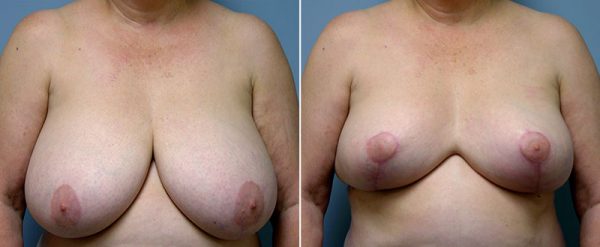 Patient Gallery » See Breast Reduction results
Patient Gallery » See Breast Reduction results
Will the reduction be permanent?
Breast reduction surgery is meant to provide lasting results. As long as you maintain a stable weight, your breast size should not change significantly over the years. However, nothing will stop the natural aging process, and skin will lose elasticity as you age, likely causing some sagging in the breasts. Also, while getting pregnant after breast reduction is safe, the procedure may hinder your ability to breastfeed, and future pregnancies are likely to affect your breast appearance.
How much does a breast reduction in Asheville cost?
At our Asheville Plastic Surgery Center, the total cost of breast reduction typically runs between $8,000 and $9,400, depending on the individual case, sometimes involving additional liposuction.
Whether you wish to pursue insurance coverage or would like information on financing and payment options, our financial specialist will be glad to help you determine what steps to take.
Will insurance cover my breast surgery?
In certain cases, breast reduction may be covered by insurance. Typically, insurance companies require documented evidence proving that conservative treatments for back, neck and shoulder pain have not helped improve the condition. Otherwise, breast reduction is considered to be cosmetic breast surgery and can be performed as an elective aesthetic procedure, with the patient responsible for the cost of surgery.
Will I need a mastopexy (lift) as well?
Dr. Conway always performs a breast lift (mastopexy) as part of breast reduction to create the most aesthetically pleasing shape to the smaller breasts. The two procedures go hand-in-hand—the breast reduction removes both excess breast tissue and skin, then a lift is performed to expertly reshape the breast. This prevents any sagging or asymmetry that may result from just a reduction alone.
Contact us for more information or to schedule a consultationIf you are considering your options for reducing your breast size, please feel free to call 828.210.9333 or contact our office in Asheville, North Carolina. We will be happy to answer any questions you have, discuss your breast surgery options, and arrange a personal consultation for you with board certified plastic surgeon Donald Conway, MD. Dr. Conway performs a variety of cosmetic and reconstructive procedures for men and women, including breast augmentation with implants, male breast reduction, tummy tuck, neck lift, and facelift.
References »
Andrades P, Prado A. Understanding modern breast reduction techniques with a simplified approach. Journal of Plastic, Reconstructive & Aesthetic Surgery. 2008 Nov;61(11):1284-93. doi: 10.1016/j.bjps.2007.11.060.
Roje Z, Roje Z, Milosević M, Varvodić J, Mance M. Current trends in breast reduction. Collegium Antropologicum. 2012 Jun;36(2):657-68.
Chiummariello S, Angelisanti M, Arleo S, Alfano C. Evaluation of the sensitivity after reduction mammoplasty. Our experience and review of the literature. Annali Italiani di Chirurgia. 2013 Jul-Aug;84(4):385-8.
Simpson AM, Donato DP, Kwok AC, Agarwal JP. Predictors of complications following breast reduction surgery: A National Surgical Quality Improvement Program study of 16,812 cases. Journal of Plastic, Reconstructive & Aesthetic Surgery. 2019 Jan;72(1):43-51. doi: 10.1016/j.bjps.2018.09.002.
Purohit S. Reduction mammoplasty. Indian Journal of Plastic Surgery. 2008 Oct;41(Suppl):S64-79. PMID: 20174545; PMCID: PMC2825129.
Hammond DC, Loffredo M. Breast reduction. Plastic and Reconstructive Surgery. 2012 May;129(5):829e-839e. doi: 10.1097/PRS.0b013e31824a2efc.
Xia TY, Scomacao I, Duraes E, Cakmakoglu C, Schwarz G. Aesthetic, Quality-of-Life, and Clinical Outcomes after Inferior Pedicle Oncoplastic Reduction Mammoplasty. Aesthetic Plastic Surgery. 2023 Jun;47(3):905-911. doi: 10.1007/s00266-023-03257-7.
